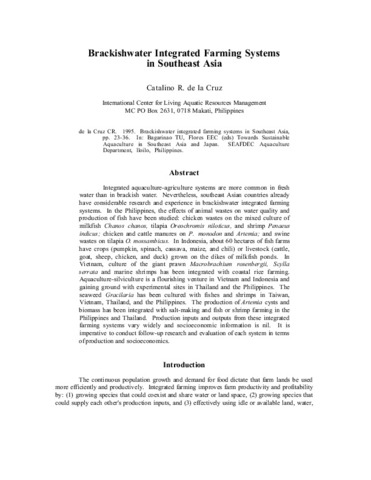Management of feeding aquaculture species
Share
Abstract
This chapter teaches the reader to: differentiate the different feeding strategies in pond culture; learn feeding management methods such as stock sampling and record keeping, calculating daily feed ration, choosing appropriate feed size, and methods of applying feeds; understand the impact of feeding management on water quality and environment and on the cultured animal’s growth, survival, and feed conversion ratio; and describe the different feeding schemes used to culture fishes (milkfish, tilapia, rabbitfish, bighead carp, native catfish, sea bass, orange-spotted grouper, and mangrove red snapper; and crustaceans (tiger shrimp and mud crab). Other species for aquaculture stock enhancement (donkey’s ear abalone, seahorses, window-pane oyster) are also discussed.
Suggested Citation
Alava, V. R. (2002). Management of feeding aquaculture species. In O. M. Millamena, R. M. Coloso, & F. P. Pascual (Eds.), Nutrition in Tropical Aquaculture: Essentials of fish nutrition, feeds, and feeding of tropical aquatic species (pp. 169-208). Tigbauan, Iloilo, Philippines: Aquaculture Department, Southeast Asian Fisheries Development Center.
Contents
- Introduction
- Feeding strategies in pond culture
- Production of natural aquatic food
- Feeding a supplementary diet
- Feeding a complete diet
- Feeding management
- Sampling and record keeping
- Feeding ration
- Feed particle size
- Feed application methods
- Feeding, water quality, and the environment
- Feeding, oxygen requirements, and water quality
- Fish farm wastes
- Performance measures
- Biomass
- Feed conversion ratio
- Feeding schemes
- Milkfish
- Tilapias
- Rabbitfish
- Bighead carp
- Native catfish
- Asian sea bass
- Orange-spotted grouper
- Mangrove red snapper
- Tiger shrimp
- Mud crabs
- Other species for Stock enhancement
- Donkey’s ear abalone
- Seahorses
- Window pane oyster
- Summary
- Guide questions
- Suggested readings
Paksa
feeding  ; artificial feeding
; artificial feeding  ; feed preparation; cultured organisms; feed efficiency
; feed preparation; cultured organisms; feed efficiency  ; feeding equipment
; feeding equipment  ; water quality
; water quality  ; feeding behaviour
; feeding behaviour  ; sampling
; sampling  ; eutrophication
; eutrophication  ; breeding stock
; breeding stock  ; fish culture
; fish culture  ; crustacean culture
; crustacean culture  ; mollusc culture
; mollusc culture  ; shrimp culture
; shrimp culture  ; pond culture
; pond culture  ; cage culture
; cage culture  ; aquaculture
; aquaculture  ; aquaculture techniques
; aquaculture techniques  ; animal nutrition
; animal nutrition  ; oysters
; oysters  ; Chanos chanos
; Chanos chanos  ; Oreochromis niloticus
; Oreochromis niloticus  ; Oreochromis mossambicus
; Oreochromis mossambicus  ; Oreochromis aureus
; Oreochromis aureus  ; Siganus guttatus
; Siganus guttatus  ; Clarias macrocephalus
; Clarias macrocephalus  ; Lates calcarifer
; Lates calcarifer  ; Epinephelus coioides
; Epinephelus coioides  ; Lutjanus argentimaculatus
; Lutjanus argentimaculatus  ; Penaeus monodon
; Penaeus monodon  ; Scylla serrata
; Scylla serrata  ; Scylla tranquebarica
; Scylla tranquebarica  ; Scylla olivacea
; Scylla olivacea  ; Haliotis asinina
; Haliotis asinina  ; Placuna placenta
; Placuna placenta  ; milkfish
; milkfish  ; tilapia
; tilapia  ; carp
; carp  ; freshwater catfish
; freshwater catfish  ; sea bass
; sea bass  ; groupers
; groupers  ; snappers
; snappers  ; prawns and shrimps
; prawns and shrimps  ; crabs
; crabs  ; abalones
; abalones 
 ; artificial feeding
; artificial feeding  ; feed preparation; cultured organisms; feed efficiency
; feed preparation; cultured organisms; feed efficiency  ; feeding equipment
; feeding equipment  ; water quality
; water quality  ; feeding behaviour
; feeding behaviour  ; sampling
; sampling  ; eutrophication
; eutrophication  ; breeding stock
; breeding stock  ; fish culture
; fish culture  ; crustacean culture
; crustacean culture  ; mollusc culture
; mollusc culture  ; shrimp culture
; shrimp culture  ; pond culture
; pond culture  ; cage culture
; cage culture  ; aquaculture
; aquaculture  ; aquaculture techniques
; aquaculture techniques  ; animal nutrition
; animal nutrition  ; oysters
; oysters  ; Chanos chanos
; Chanos chanos  ; Oreochromis niloticus
; Oreochromis niloticus  ; Oreochromis mossambicus
; Oreochromis mossambicus  ; Oreochromis aureus
; Oreochromis aureus  ; Siganus guttatus
; Siganus guttatus  ; Clarias macrocephalus
; Clarias macrocephalus  ; Lates calcarifer
; Lates calcarifer  ; Epinephelus coioides
; Epinephelus coioides  ; Lutjanus argentimaculatus
; Lutjanus argentimaculatus  ; Penaeus monodon
; Penaeus monodon  ; Scylla serrata
; Scylla serrata  ; Scylla tranquebarica
; Scylla tranquebarica  ; Scylla olivacea
; Scylla olivacea  ; Haliotis asinina
; Haliotis asinina  ; Placuna placenta
; Placuna placenta  ; milkfish
; milkfish  ; tilapia
; tilapia  ; carp
; carp  ; freshwater catfish
; freshwater catfish  ; sea bass
; sea bass  ; groupers
; groupers  ; snappers
; snappers  ; prawns and shrimps
; prawns and shrimps  ; crabs
; crabs  ; abalones
; abalones 
Taxonomic term
Related items
Showing items related by title, author, creator and subject.
-
Brackishwater integrated farming systems in Southeast Asia
De la Cruz, Catalino R. (Aquaculture Department, Southeast Asian Fisheries Development Center, 1995)Integrated aquaculture-agriculture systems are more common in fresh water than in brackish water. Nevertheless, southeast Asian countries already have considerable research and experience in brackishwater integrated farming ... -
Research on marine and freshwater fishes
Emata, Arnil C. (Aquaculture Department, Southeast Asian Fisheries Development Center, 1995)Most of the fish research at SEAFDEC AQD in 1992-1994 was on milkfish. Studies were conducted on year-round spawning through hormonal or environmental manipulation; optimum lipid and protein levels and ration size for ... -
Aquaculture development in Singapore
Cheong, Leslie. (Aquaculture Department, Southeast Asian Fisheries Development Center, 1988)The trend of fish production in Singapore is towards increasing contribution from marine and brackishwater aquaculture. Aquaculture production in 1986 represented 6.8% of local fish production. It is envisaged that this ...





